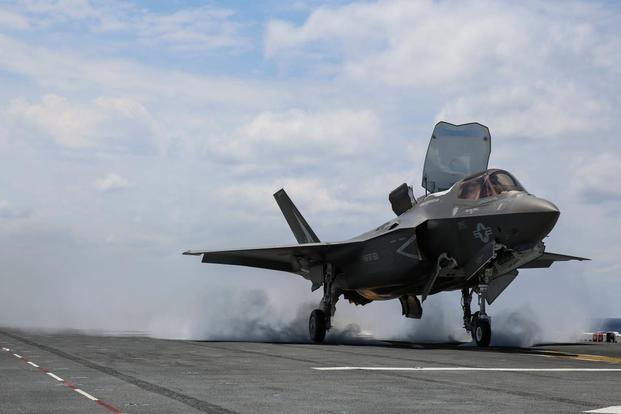The Marine Corps is finishing up its first round of operational testing for its F-35B short-take-off-and-landing Joint Strike Fighter on board the USS WASP, an amphibious assault ship in the Atlantic Ocean, service officials said.
The tests -- seen as a key final step before the aircraft becomes operational later this year -- included night-time take-off and landings as well as a wide range of assessments placing the aircraft is various operational circumstances.
The Marine Corps F-35 "B" variant, slated to reach what's called initial operating capability this summer, is a stealth aircraft specially engineered to land vertically, meaning without a runway.
This ability to land vertically without a runway is designed to give the Navy and Marine Corps the ability to use the aircraft from a smaller amphibious platform without needing the catapult or large runway of an aircraft carrier, Corps officials explained.
The pilots conducting the tests had to successfully complete at least four night time landing operations, Corps officials said.
"We use the night pattern for unaided recovery," Maj. Michael Roundtree, an F-35B test pilot, said in a Marine Corps statement. "We are not approved to use the night vision camera, or distributed aperture system in the ship environment yet. We are simply using the naked eye to get us onto the ship. We fly an approach that funnels us into a good position to take over and land the jet visually."
Rountree also said the nighttime landings, while more challenging, went smoothly during the testing.
The operational tests come on the heels of Sea Trials last year aboard the USS WASP which resulted in at least 90 successful short take-offs and 92 vertical landings aboard the ship, JSF officials said.
The Sea Trials also demonstrated night take-offs and vertical landings and tested how the aircraft handled in high winds as strong as 35 knots, Corps officials said.
The F-35Bs participating in the operational flight tests are from the Marine Fighter Attack Squadron 121, based in Yuma, Arizona, a Corps statement said.
The new Corps aircraft will be replacing three existing platforms, including the AV-8 Harrier, the F/A-18 Hornet and the EA-6B Prowler, Corps officials said.
Pilots from the British Royal Navy also participated in the operational testing aboard the USS Wasp; the F-35B is slated to serve aboard the United Kingdoms' new aircraft carrier, the Queen Elizabeth.
Slated to enter service in 2020, the 65,000-ton Queen Elizabeth is the largest warship ever built by the UK. It will be the first in a series of two planned Queen Elizabeth-class aircraft carriers, ships being engineered to house and sustain as many as 36 JSF aircraft, BAE officials have said.
The JSF program developmental strategy is, in part, grounded upon a series of incremental software "drops" - each one adding new capability to the platform. In total, there are more than 10 billion individual lines of code for the system, broken down into increments and "blocks," F-35 program office officials explained.
The F-35B is slated to deploy with Block 2B, software which enables the aircraft to provide basic close air support and fire an AMRAAM [Advanced Medium Range Air to Air Missile], JDAM [Joint Direct Attack Munition], or GBU 12 [laser-guided aerial bomb].
-- Kris Osborn can be reached at Kris.Osborn@military.comKris.Osborn@military.com


























